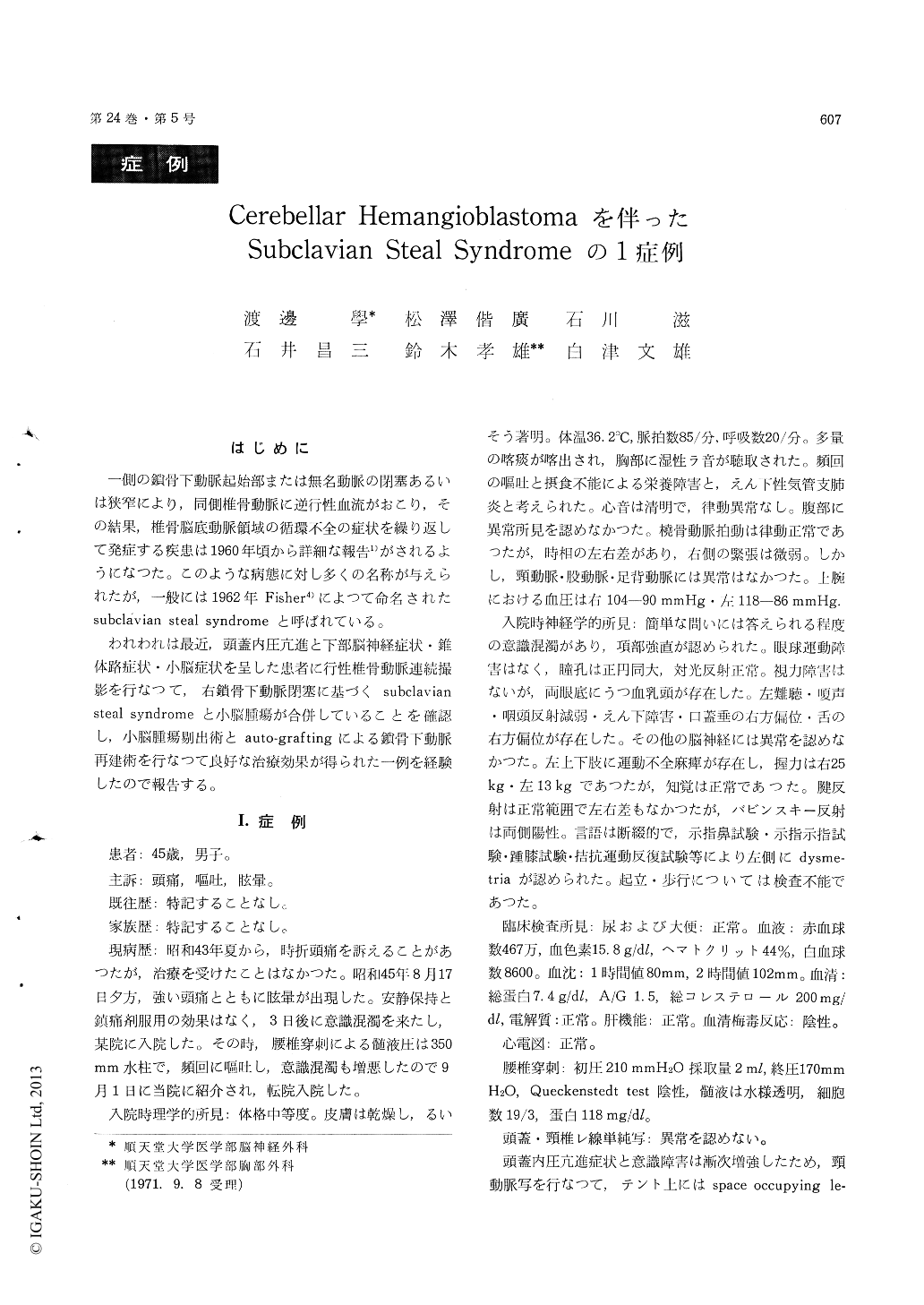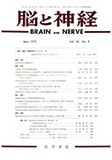Japanese
English
- 有料閲覧
- Abstract 文献概要
- 1ページ目 Look Inside
はじめに
一側の鎖骨下動脈起始部または無名動脈の閉塞あるいは狭窄により,同側椎骨動脈に逆行性血流がおこり,その結果,椎骨脳底動脈領域の循環不全の症状を繰り返して発症する疾患は1960年頃から詳細な報告1)がされるようになつた。このような病態に対し多くの名称が与えられたが,一般には1962年Fisher4)によつて命名されたsubclavian steal syndromeと呼ばれている。
われわれは最近,頭蓋内圧亢進と下部脳神経症状・錐体路症状・小脳症状を呈した患者に行性椎骨動脈連続撮影を行なつて,右鎖骨下動脈閉塞に基づくsubclaviansteal syndromeと小脳腫瘍が合併していることを確認し,小脳腫瘍別出術とauto-graftingによる鎖骨下動脈再建術を行なつて良好な治療効果が得られた一例を経験したので報告する。
This is a report of a case who has suffered from the cerebellar tumor convined with the "subclavian steal syndrome" due to obstruction of the right subclavian artery.
The patient, 45 years old male, was suddenly developed severe headache associated with vomiting and admitted to the Juntendo University Hospital with additional symptom of gradual drop of conscious level on August 17 in 1969.
On admission, examinations revealed the increased intracranial pressure, paresis of the left 8th through 12th cranial nerves, left cerebellar hemisphere signs and left hemiparesis. Radial pulsation on both side was not synchronous and systolic blood pressure on the right side was 14 mmHg lower than that on the left side.
Ventriculo-auriculostomy was immediately fol-lowed by clearing of consciousness and disappear-ance of the signs of intracranial hypertension.
Retrograde vertebral angiogram demonstrated a tumor stain surrounded by the round avascular area in the left cerebellar hemisphere.
Retrograde vertebral angiogram showed that the contrast medium did go up until the basilar artery then flow down the right vertebral artery to the right brachial artery via subclavian artery. When a retrograde angiography was made from the right brachial artery neither left common carotid nor innominating artery was demonstrated and the right subclavian artery ended blindly. Contrast medium which once did go up the right vertebral artery returned on the same route again after the completion of injection.
On September 21, suboccipital craniectomy was carried out and cystic tumor with thumb-tip sized mural nodule on the left cerebellar hemisphere was removed. Histological diagnosis of the tumor was hemangioblastoma.
Postoperative course was uneventful and the patient showed continuous improvement until No-vember 5 when he developed rather suddenly the paresis of lower cranial nerves, cerebellar and pyramidal signs associated with headache.
On December 10, reconstruction of the right subclavian artery was carried out. Using a piece from the internal iliac artery an autograft was made between the proximal end of right carotid artery and subclavian artery. Following the second surgery, almost complete disappearance of neurolo-gical abnormalities resulted and no recurrence of symptoms occurs for 8 months follow-up period.

Copyright © 1972, Igaku-Shoin Ltd. All rights reserved.


